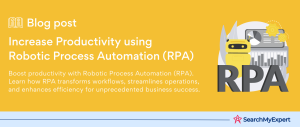Robotic Process Automation in Supply Chain Management
Robotic Process Automation (RPA): A Revolution in Efficiency and Accuracy
Imagine a world where repetitive, tedious tasks in supply chain management are handled swiftly, accurately, and tirelessly by intelligent software robots. That’s the realm of Robotic Process Automation (RPA). At its core, RPA involves deploying software bots that emulate human actions, performing tasks within digital systems. These bots interact with applications, process data, and execute complex workflows, often with remarkable precision and speed.
The Dynamic Nature of Today’s Supply Chains: Challenges and Opportunities
In the fast-paced business landscape, modern supply chains are more dynamic than ever. They must adapt to rapid market changes, fluctuating demand, and evolving consumer behaviors. This agility, however, comes with its share of challenges:
- Managing vast data volumes
- Ensuring timely delivery amidst disruptions
- Maintaining cost efficiency
- Upholding quality and compliance standards
Automating for Agility: RPA’s Role in Supply Chain Management
Enter the transformative power of RPA. By automating routine supply chain operations, RPA offers a plethora of benefits:
- Enhanced Efficiency:
Bots work round the clock, processing tasks faster than humans. - Reduced Errors:
Automation minimizes human error, enhancing data accuracy. - Cost Savings: Lower operational costs as bots take over manual, repetitive tasks.
- Scalability: Easy adaptation to changing workloads without additional human resources.
- Data Analytics: Improved decision-making through accurate, real-time data analysis.
- Customer Satisfaction: Faster response times and improved service quality.
RPA stands as a beacon of innovation, promising to revolutionize supply chain management by offering unprecedented efficiency, agility, and accuracy.
RPA Applications in Supply Chain Management
Unleashing Efficiency: RPA’s Role Across the Supply Chain Spectrum
Robotic Process Automation is not just a tool; it’s a game-changer in the realm of supply chain management. Here, we delve into key areas where RPA leaves its indelible mark, transforming operations from mundane to magnificent.
Order Processing and Fulfillment: The Speed of Light
- Automation Magic: Automate order entry, validation, and updates.
- Impact:
Slash processing times, improve accuracy, and elevate customer satisfaction.
Inventory Management and Tracking: The Art of Balance
- Automation Magic:
Monitor stock levels, trigger restocking, and update inventory records. - Impact:
Minimize overstock/understock scenarios and optimize warehouse space.
Procurement and Supplier Management: The Strategic Alliance
- Automation Magic:
Automate purchase order creation, supplier evaluation, and contract management. - Impact: Streamline procurement, ensure compliance, and enhance supplier relationships.
Logistics and Transportation Planning: The Symphony of Movement
- Automation Magic: Optimize route planning, freight auditing, and shipment scheduling.
- Impact: Reduce transportation costs, improve delivery times, and ensure shipment accuracy.
Customer Service and Communication: The Voice of Trust
- Automation Magic:
Automate responses to standard queries, track order status, and send notifications. - Impact: Boost customer engagement, reduce response times, and enhance brand loyalty.
Data Analysis and Reporting: The Insight Factory
- Automation Magic:
Generate real-time reports, conduct trend analysis, and monitor KPIs. - Impact: Enable informed decision-making, identify trends, and drive continuous improvement.
In these realms, RPA doesn’t just automate; it reinvents. It brings a new dawn of efficiency, precision, and strategic insight, propelling supply chains into a future where challenges transform into opportunities.
Benefits of RPA in Supply Chain Management
The Transformative Impact: Measuring RPA’s Value
Robotic Process Automation is not just a tool; it’s a catalyst for transformative change in supply chain management. Let’s quantify its impact across various dimensions:
Skyrocketing Efficiency and Productivity
- Metric Impact: Increases productivity by up to 50%.
- Real-World Example: A logistics company automated data entry, achieving a 40% increase in processing speed.
- Why It Matters:
Time saved is money earned. Efficiency translates to faster service and more business.
Dramatic Cost Reduction
- Metric Impact:
Reduces operational costs by 25-50%. - Real-World Example:
An e-commerce firm saved 30% in costs by automating order processing. - Why It Matters:
Lower costs mean competitive pricing and higher margins.
Unparalleled Accuracy and Error Reduction
- Metric Impact:
Improves data accuracy by over 90%. - Real-World Example:
A retail chain reduced data entry errors by 95% through RPA. - Why It Matters:
Accuracy mitigates risks and enhances compliance.
Enhanced Visibility and Traceability
- Metric Impact: Increases supply chain transparency by up to 60%.
- Real-World Example:
A manufacturer gained real-time inventory visibility, reducing stock discrepancies. - Why It Matters:
Better visibility leads to informed decisions and agile responses.
Boosted Customer Satisfaction
- Metric Impact:
Improves customer response times by 80%. - Real-World Example:
A service provider improved customer query resolution time by 70%. - Why It Matters:
Happy customers are loyal customers, fueling business growth.
RPA in supply chain management is not just about automation; it’s about redefining performance standards, delivering unprecedented value, and driving business growth.
Challenges and Considerations of RPA Implementation
Navigating the Maze: Understanding RPA’s Implementation Hurdles
Robotic Process Automation, while transformative, is not without its challenges. Let’s explore the key hurdles businesses face when implementing RPA in supply chain management.
Bridging the Knowledge Gap: Lack of Awareness and Understanding
- The Challenge:
Many organizations lack a deep understanding of RPA’s capabilities and limitations. - Real-World Implication:
A retailer struggled to identify suitable processes for automation, leading to underutilization of RPA. - Mitigation Strategy:
Invest in training and workshops to educate stakeholders on RPA’s potential and best practices.
The Integration Puzzle: Meshing with Existing Systems
- The Challenge: Seamlessly integrating RPA with legacy systems and data structures can be complex.
- Real-World Implication:
A logistics firm faced difficulties integrating RPA with its outdated inventory management system. - Mitigation Strategy: Conduct a thorough IT infrastructure assessment and involve IT experts in the planning phase.
Security and Compliance: Safeguarding Data
- The Challenge: Ensuring RPA solutions comply with data security and regulatory standards.
- Real-World Implication:
A financial services provider encountered compliance issues due to RPA-related data breaches. - Mitigation Strategy: Implement robust data protection measures and regularly update compliance protocols.
The Human Factor: Change Management and Workforce Considerations
- The Challenge:
Addressing workforce apprehension and managing the transition to automation. - Real-World Implication: A manufacturing company faced resistance from employees fearing job displacement.
- Mitigation Strategy: Foster a culture of transparency, provide reskilling opportunities, and highlight RPA as a tool for enhancing job roles.
Understanding and addressing these challenges is crucial for a successful RPA implementation, ensuring a smooth journey towards automation excellence in supply chain management.
Real-World Examples of RPA Success in Supply Chains
Trailblazers of Transformation: How RPA Rewrites Success Stories
The true potential of Robotic Process Automation in supply chains is best illustrated through real-world examples. Here are case studies of companies achieving groundbreaking results with RPA.
Retail Revolution: Automating Order Fulfillment
- Company: A leading global retail giant.
- Challenge:
Managing a high volume of orders with accuracy and speed. - RPA Solution:
Automated the entire order processing and fulfillment system. - Outcome:
- Efficiency Boost:
Achieved 60% faster order processing. - Error Reduction:
Reduced order inaccuracies by 70%. - Customer Satisfaction: Enhanced customer experience with quicker delivery times.
Manufacturing Marvel: Boosting Inventory Accuracy
- Company:
An international manufacturing conglomerate. - Challenge:
Maintaining accurate inventory levels across global warehouses. - RPA Solution: Implemented RPA for real-time inventory tracking and reconciliation.
- Outcome:
- Inventory Precision: Improved inventory accuracy by 90%.
- Cost Savings: Reduced inventory holding costs by 30%.
- Operational Excellence:
Streamlined warehouse operations.
Logistics Leap: Enhancing Shipment Tracking
- Company:
A major logistics and transportation provider. - Challenge:
Ensuring real-time tracking of shipments globally. - RPA Solution:
Automated shipment tracking and status update system. - Outcome:
- Visibility Enhanced:
Achieved 95% accuracy in shipment tracking. - Customer Trust: Improved customer communication and trust.
- Operational Efficiency:
Optimized routing and delivery schedules.
These case studies are not just success stories; they are beacons of inspiration, showcasing how RPA can revolutionize supply chain management by delivering exceptional results.
The Future of RPA in Supply Chain Management
Charting the Course: Emerging Trends in RPA
The landscape of Robotic Process Automation in supply chain management is evolving rapidly, driven by technological advancements and innovative applications. Let’s explore the emerging trends that are shaping the future of RPA.
AI and Machine Learning Integration: The Smart Revolution
Trend Insight:
RPA is increasingly integrating with AI and machine learning to enhance decision-making and predictive analytics.
Future Impact:
- Predictive Analytics:
AI-driven bots will predict supply chain disruptions and suggest proactive measures. - Enhanced Decision Making:
AI integration will enable more complex, data-driven decisions.
Cognitive Automation and Process Mining: The Insight Accelerators
Trend Insight: Cognitive automation, coupled with process mining, is transforming RPA into a more intelligent tool.
Future Impact:
- Process Optimization: Identify and automate not just repetitive tasks, but also complex processes.
- Continuous Improvement:
Real-time monitoring and optimization of supply chain processes.
Cloud-based RPA Solutions: The Scalability Frontier
Trend Insight:
Cloud-based RPA solutions are emerging, offering scalability and flexibility.
Future Impact:
- Scalability: Easily scale RPA solutions up or down based on demand.
- Accessibility:
Greater accessibility for businesses of all sizes, encouraging widespread adoption.
These trends indicate that the future of RPA in supply chain management is not just about automation, but about creating smarter, more adaptable, and highly efficient supply chain ecosystems.
Revolutionizing the Landscape: RPA’s Transformative Potential
Robotic Process Automation (RPA) has emerged as a potent force, not just automating tasks, but fundamentally reshaping the landscape of supply chain management. Its impact transcends mere efficiency gains, ushering in a new era of:
- Enhanced Agility and Resilience:
RPA empowers rapid adaptation to volatile market dynamics and unforeseen disruptions. By automating routine processes, it frees human resources to focus on strategic decision-making and proactive measures, enabling businesses to navigate through
challenges with greater agility and resilience. - Profound Visibility and Transparency:
The opaque, siloed nature of traditional supply chains often hinders optimization efforts. RPA bridges this gap by integrating disparate systems and consolidating data into a single, transparent platform. This real-time visibility empowers better forecasting, optimized inventory management, and improved collaboration across the entire supply chain ecosystem. - Unleashing the Power of Data: Supply chains generate vast amounts of data, often underutilized due to manual processing limitations. RPA unlocks the potential of this data by automating extraction, analysis, and reporting. This data-driven approach enables informed decision-making, predictive maintenance, and proactive risk mitigation, driving continuous improvement across the chain.
- Human-Robot Synergy: Contrary to fears of job displacement, RPA fosters a synergistic relationship between humans and technology. By removing the burden of repetitive tasks, RPA liberates human employees to focus on higher-order cognitive functions, creativity, and strategic problem-solving. This collaboration enhances overall productivity, employee satisfaction, and organizational growth.
- Sustainable Optimization:
RPA contributes to a more sustainable supply chain by reducing errors, inefficiencies, and waste. Through optimized logistics, improved inventory management, and reduced paper consumption, businesses can operate with a lower environmental footprint, aligning with increasingly stringent sustainability regulations and evolving consumer preferences.
A Call to Action: Embracing the Future of Supply Chain Management
While the transformative potential of RPA is undeniable, its successful implementation requires a proactive approach. Organizations must:
- Invest in Awareness and Education:
Cultivating a culture of understanding and appreciation for RPA within the workforce is crucial to overcoming resistance and fostering acceptance. Comprehensive training programs should equip employees with the skills to collaborate effectively with their robotic counterparts. - Prioritize Strategic Implementation:
Identifying and prioritizing key processes for RPA automation ensures maximum impact. A data-driven approach, combined with expert guidance, helps pinpoint areas where RPA can deliver the most significant improvements in efficiency, cost reduction, and accuracy. - Embrace Continuous Improvement: RPA is not a static solution. Continuous monitoring, evaluating, and optimizing RPA deployment ensures sustained benefits and adaptation to evolving needs. Integrating feedback from various stakeholders and leveraging advanced analytics helps refine processes and maximize RPA’s value.
- Forge Strategic Partnerships:
Collaborating with experienced RPA solution providers and consultants accelerates the journey. Their expertise in technology selection, implementation, and ongoing support empowers organizations to navigate the intricacies of RPA adoption and achieve optimal results.
The future of supply chain management is inextricably linked to the rise of RPA. By embracing this transformative technology and fostering a culture of innovation, organizations can unlock unprecedented levels of efficiency, resilience, and competitiveness. The time for action is now. Those who seize the opportunity to harness the power of RPA will stand as leaders in the ever-evolving landscape of modern supply chains.
Conclusion
RPA is a game-changer for supply chains! It speeds things up, cuts costs, and lets you see everything that’s happening. By making robots handle the boring stuff, humans can focus on strategy and growth. Embrace RPA now and build a winning supply chain for the future!
Empower your business with cutting-edge Robotic Process Automation Services.
Further Reading
- Cloud-Based Solutions in Robotic Process Automation
- Robotic Process Automation in Manufacturing
- Building a Robotic Process Automation Center of Excellence
- Robotic Process Automation and Digital Transformation
- Robotic Process Automation for Small and Medium Enterprises
- Future Trends in Robotic Process Automation
Table of Contents
Toggle






